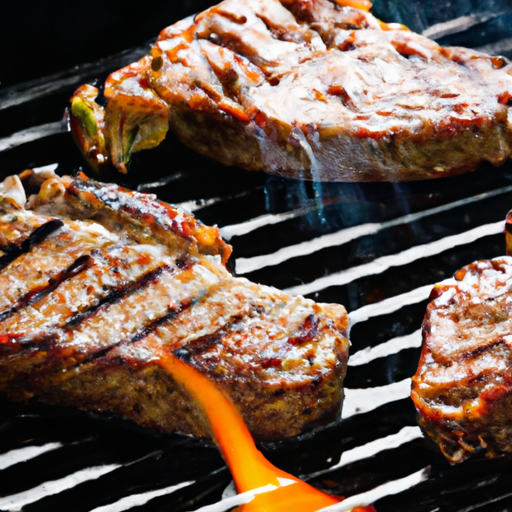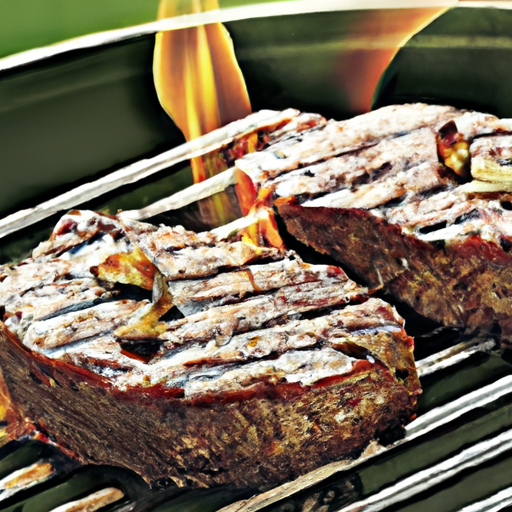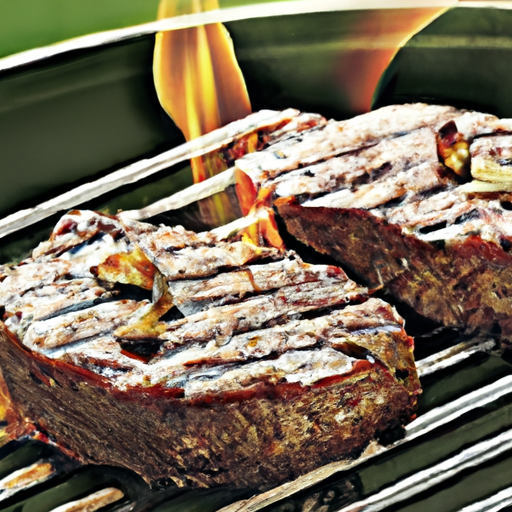Are you ready to take your grilling skills to the next level? Look no further than the Omaha Steaks Grilling Guide. Packed with expert tips, mouthwatering recipes, and a handy cooking chart for burgers, this guide is your one-stop resource for becoming the ultimate grill master. Whether you’re a beginner or a seasoned pro, the Omaha Steaks Grilling Guide has everything you need to make your next cookout a sizzling success. Get ready to impress your friends and family with perfectly cooked steaks, juicy burgers, and flavorful barbecued chicken. Say goodbye to overcooked meat and hello to grilling perfection with the Omaha Steaks Grilling Guide.
Omaha Steaks Grilling Guide
Welcome to the Omaha Steaks Grilling Guide, where we’ll take you through all the essential tips and techniques to help you become a grilling master! Whether you’re a seasoned grill enthusiast or a newbie, this comprehensive guide has got you covered. From choosing the right cuts of meat to mastering grilling techniques and incorporating delicious flavors, we’ll walk you through every step of the grilling process. So grab your apron and fire up the grill – it’s time to grill like a pro!
Choosing the Right Cuts
When it comes to grilling, selecting the right cuts of meat is crucial for achieving tender and flavorful results. Fortunately, Omaha Steaks offers a wide variety of high-quality cuts to choose from. Here’s a breakdown of the best cuts for grilling:
Selecting the Best Beef Cuts
When it comes to beef, you can’t go wrong with classics like ribeye, filet mignon, New York strip, and T-bone steaks. These cuts are known for their marbling and tenderness, making them perfect for grilling. For those who prefer a leaner option, top sirloin and flat iron steaks are excellent choices. Don’t forget about burgers! Omaha Steaks offers premium ground beef that can be shaped into juicy patties for a classic grilled treat.
Optimal Pork Cuts
Pork is incredibly versatile and offers a range of delicious options for the grill. Pork chops, tenderloins, and ribs are all excellent choices. Choose bone-in cuts for extra juiciness and flavor. If you’re craving something a little different, consider grilling pork sausages or kabobs for a flavorful twist.
Poultry Cuts for Grilling
From chicken breasts to whole chickens, Omaha Steaks has a variety of poultry options that are perfect for grilling. Boneless and skinless chicken breasts are a popular choice for their versatility, but don’t overlook bone-in chicken thighs or drumsticks for a more succulent and flavorful result. And if you’re feeling adventurous, try grilling a whole chicken for a show-stopping centerpiece.
Delicious Seafood Options
Grilling seafood adds a unique and delicious flavor to your dishes. Omaha Steaks offers a selection of seafood options, including salmon fillets, shrimp, and lobster tails. These options are perfect for creating mouthwatering grilled seafood dishes that are sure to impress. So whether you’re a seafood lover or want to incorporate more variety into your grilling repertoire, don’t miss out on these delectable options.

Preparing Your Grill
Before you dive into the grilling process, it’s important to properly prepare your grill to ensure optimal grilling results. Here are some key steps to get your grill ready:
Cleaning and Maintenance
Start by cleaning your grill grates to remove any leftover residue from previous grilling sessions. Scrub the grates with a wire brush to remove any stuck-on food particles. Regular maintenance, such as cleaning the exterior and checking for gas leaks for gas grills, will help keep your grill in top shape for years to come.
Different Types of Grills
There are several types of grills to choose from, including gas, charcoal, and pellet grills. Each type has its unique advantages and flavor profiles, so consider your personal preferences and the type of cooking experience you want to achieve. Gas grills offer convenience and precise temperature control, while charcoal grills give that traditional smoky flavor. Pellet grills provide versatility with the option to smoke, grill, or bake.
Preheating Your Grill
Preheating your grill is a crucial step to ensure even cooking and to help prevent food from sticking to the grates. Allow your grill to preheat for about 10-15 minutes, reaching your desired grilling temperature. This step ensures that your grill is hot enough to sear the meat, resulting in those coveted grill marks and delicious caramelization.
Grilling Safety Tips
Safety should always be a top priority when grilling. Keep a safe distance from the grill while it’s hot, use long-handled grilling tools to avoid burns, and never leave the grill unattended. Make sure to use a meat thermometer to ensure that your meat reaches the appropriate internal temperature to avoid any foodborne illness.
Grilling Techniques
Now that you have your grill prepared, it’s time to dive into the different grilling techniques that you can use to elevate your cooking. Understanding these techniques will help you achieve the desired level of doneness, texture, and flavor in your grilled dishes. Let’s explore some key grilling techniques:
Direct vs. Indirect Heat
Direct heat grilling involves cooking food directly above the heat source, such as a flame or hot coals. This technique is ideal for foods that cook quickly, like steaks and burgers. Indirect heat grilling, on the other hand, involves cooking food next to the heat source rather than directly over it. This is great for larger cuts of meat, such as roasts or whole chickens, as it allows for slower, more even cooking.
Searing and Caramelization
Searing your meat at high heat is an excellent technique for achieving a flavorful crust and locking in the juices. It’s important to preheat your grill to high heat and sear the meat for a few minutes on each side before adjusting the heat or moving the meat to indirect heat. This technique creates those beautiful grill marks and adds depth of flavor through caramelization.
Using Wood Chips and Charcoal
For charcoal grills, adding wood chips or chunks can enhance the flavor of your grilled dishes. Soak the wood chips in water beforehand to create smoke when added to the charcoal. Different woods, such as hickory or mesquite, can impart unique flavors to your food. Experiment with different combinations to find your favorite smoke flavor profile.
Smoking Techniques
Smoking is a fantastic way to infuse your food with rich, smoky flavors. Whether you’re using a dedicated smoker or a grill with a smoker box, smoking allows for slow cooking at low temperatures. This technique is perfect for meats like ribs and brisket, as it results in incredibly tender and flavorful results. Don’t forget to add your favorite wood chips or chunks for that extra layer of smokiness.

Temperature and Timing
Properly gauging the temperature and ensuring the right timing are essential factors in achieving perfectly cooked grilled meals. Here are some key tips and techniques for maintaining ideal temperature and cooking times:
Determining Meat Doneness
The doneness of meat is typically measured by its internal temperature. Invest in a meat thermometer to accurately gauge the doneness of your grilled meats. The USDA provides guidelines for safe internal temperatures for various types of meat. For example, medium-rare beef is typically cooked to 135°F (57°C), while pork chops should reach an internal temperature of 145°F (63°C).
Using a Meat Thermometer
A meat thermometer is an indispensable tool for grilling. Insert the probe into the thickest part of the meat, away from any bones. This will provide an accurate reading of the internal temperature. Be sure to clean and sanitize your thermometer after each use to maintain food safety.
Resting Periods
Allowing your grilled meat to rest after cooking is crucial for preserving its juiciness and tenderness. During the resting period, the meat’s juices redistribute, resulting in a more flavorful bite. As a general rule, let your meat rest for approximately 5-10 minutes before slicing or serving.
Cooking Times for Different Cuts
The cooking time for different cuts of meat can vary depending on their thickness and desired level of doneness. Omaha Steaks provides a comprehensive cooking chart that details recommended cooking times for various cuts of meat. Use this as a guide, but always rely on your meat thermometer for accurate doneness measurements.
Grilling Tools and Accessories
To enhance your grilling experience, having the right tools and accessories is essential. Here are some must-have items that will make your grilling journey more enjoyable:
Essential Grilling Tools
Investing in high-quality grilling tools is a wise decision. A sturdy spatula, tongs, and a long-handled fork are must-haves for handling and flipping your food. A basting brush can be handy for applying marinades or glazes, while a grill brush helps keep your grates clean.
Grill Brush and Cleaning Accessories
Regular maintenance and cleaning of your grill are vital for extending its lifespan and ensuring optimal cooking conditions. A grill brush with stainless steel bristles is ideal for removing grease and debris from your grates. Additionally, consider using grill cleaning accessories like scrapers or grill stones to achieve a thorough clean.
Grilling Baskets and Skewers
Grilling baskets and skewers are fantastic accessories that expand the variety of foods you can cook on the grill. Baskets are perfect for grilling delicate items like fish or vegetables, preventing them from falling through the grates. Skewers, whether metal or bamboo, are excellent for creating kebabs or grilling small ingredients like shrimp or diced vegetables.
Meat Tenderizers and Thermometers
A meat tenderizer can help break down tough muscle fibers and improve the tenderness of your meat. It’s a handy tool to have, especially for larger cuts like steaks or roasts. Pair your tenderizer with a reliable meat thermometer to ensure perfect doneness every time.
Marinades and Rubs
Marinades and rubs are key players in flavoring your grilled dishes. They can add depth, tenderness, and unique taste profiles to your meat, poultry, seafood, or vegetables. Here’s what you need to know about marinades and rubs:
Creating Flavorful Marinades
Marinades are a combination of various ingredients that infuse flavor into your food. They typically consist of an acid (such as citrus juice or vinegar), oil, herbs, spices, and other seasonings. You can create marinades that range from tangy and citrusy to sweet and savory, depending on your personal preferences. Experiment with different flavor combinations to find your perfect marinade.
Dry Rubs vs. Wet Marinades
Dry rubs and wet marinades are two popular methods of flavoring your grilled dishes. Dry rubs are a mixture of dry spices, herbs, and seasonings that are rubbed onto the surface of your meat. They create a flavorful crust on the outside and penetrate the meat during cooking. Wet marinades, as the name suggests, involve soaking your meat in a liquid mixture to infuse flavors. Both methods have their merits and can be used depending on the desired taste and texture.
Tips for Marinating
Marinating is an excellent way to tenderize and flavor your meats, but it’s important to marinate properly. Ensure that your meat is fully coated in the marinade and allow enough time for the flavors to penetrate. Marinating times can vary depending on the type and size of the meat, but a general guideline is to marinate for at least 30 minutes or up to overnight in the refrigerator.
Safe Handling of Marinades
Since marinades often come into contact with raw meat, it’s essential to handle them with care to prevent any foodborne illnesses. Always marinate in the refrigerator, rather than at room temperature. If you plan to use the marinade as a sauce or glaze, make sure to bring it to a boil first to kill any bacteria from the raw meat.
Grilling Vegetables
Grilling isn’t just for meat lovers – it’s also a fantastic way to elevate the flavors and textures of vegetables. Whether you’re a vegetarian or just looking to incorporate more veggies into your grilling repertoire, here are some tips for grilling vegetables to perfection:
Preparing Vegetables for Grilling
Start by washing and drying your vegetables thoroughly. You can grill a wide range of vegetables, including bell peppers, zucchini, corn, eggplant, mushrooms, and onions. Slice them into uniform sizes to ensure even cooking. If you’re grilling smaller or delicate vegetables like cherry tomatoes or asparagus, consider using grilling baskets or skewers to prevent them from falling through the grates.
Grilling Techniques for Different Vegetables
Various vegetables require different grilling techniques to achieve the ideal texture and flavor. Hardier vegetables like bell peppers and onions can be grilled directly over medium heat until they are charred and tender. Delicate vegetables like asparagus or sliced zucchini may require a shorter cooking time or indirect grilling to avoid overcooking. Pay attention to the texture and adjust your grilling technique accordingly.
Seasoning and Flavors
Seasoning can elevate the natural flavors of vegetables and make them even more delicious. Brush your vegetables with olive oil to prevent sticking and enhance their smoky flavors. Sprinkle them with salt, pepper, and your favorite herbs or spices to add a burst of flavor. Additionally, drizzling a balsamic glaze or a squeeze of lemon juice can add a tangy twist to grilled vegetables.
Creative Vegetable Grilling Ideas
Grilled vegetables can be enjoyed in various ways beyond being a side dish. You can toss them with cooked pasta or quinoa for a refreshing summer salad, stuff them into sandwiches or wraps for a flavorful crunch, or blend them into dips or salsas for a healthy appetizer. Get creative with your grilled vegetables and explore different recipes to unlock their full potential.
Grilling Seafood
Expand your grilling horizons by venturing into the realm of grilled seafood. Grilling seafood imparts a unique smoky flavor and enhances its natural sweetness. Whether you’re a seafood lover or want to explore new flavors, here are some tips for grilling seafood to perfection:
Choosing and Preparing Seafood
When selecting seafood for grilling, opt for firm-fleshed fish fillets like salmon, halibut, or tuna. Shellfish like shrimp, scallops, and lobster tails are also excellent choices. Make sure to clean and pat dry your seafood before marinating or seasoning. If using wooden skewers for kebabs, soak them in water for at least 30 minutes to prevent them from burning on the grill.
Grilling Techniques for Different Seafood
Different types of seafood require varying grilling techniques to achieve optimal results. Fish fillets can be grilled directly over medium-high heat, skin-side down, until they are opaque and flake easily. Shellfish like shrimp or scallops are best threaded onto skewers and grilled quickly over high heat until opaque. Lobster tails can be split in half lengthwise and grilled until the meat is firm and opaque.
Enhancing Seafood Flavors
Seafood has a delicate flavor that can be enhanced with simple seasonings. Brush your seafood with olive oil or melted butter before grilling to prevent sticking and add richness. Season with salt, pepper, and your favorite herbs or spices to complement the natural flavors. For a burst of fresh citrus, squeeze lemon or lime juice over your grilled seafood just before serving.
Recipe Ideas for Grilled Seafood
Grilled seafood opens up a world of culinary possibilities. From grilled salmon with a soy glaze to shrimp skewers with a zesty marinade, there are countless recipe ideas to explore. Serve your grilled seafood on a bed of rice or alongside grilled vegetables for a complete and flavorful meal. Get creative in the kitchen and discover your favorite grilled seafood recipes.
Grilling Pork
From succulent pork chops to mouthwatering ribs, grilling pork is a surefire way to delight your taste buds. Here are some tips and techniques for grilling pork to perfection:
Preparing Different Cuts of Pork
Pork offers a variety of cuts that are perfect for grilling. Bone-in pork chops, such as rib or loin chops, are incredibly flavorful and juicy when grilled. Tenderloins, both whole or sliced into medallions, are a lean and tender option. Ribs, whether baby back or spare, benefit from low and slow cooking to achieve fall-off-the-bone tenderness. Experiment with different cuts and discover your personal favorites.
Grilling Techniques for Pork
Grilling pork requires attention to temperature and timing to ensure optimal results. Start by searing your pork over high heat to lock in the juices and create a flavorful crust. Then, reduce the heat or move the meat to indirect heat to allow for more gentle cooking. Baste with your favorite marinade or glaze in the final stages of grilling to add a glaze and enhance the flavors.
Enhancing Pork Flavors
Pork pairs well with a variety of flavors and seasonings. Consider marinating your pork before grilling to add depth and tenderness. Sweet and tangy marinades, such as honey mustard or apple cider vinegar-based ones, complement the natural sweetness of the pork. Season with your favorite spices and herbs, like garlic, rosemary, or paprika, to enhance the flavors even further.
Recommended Pork Recipes
Grilling pork opens up a world of delicious possibilities. From classic grilled pork chops with a smoky BBQ glaze to savory grilled pork tenderloin with a tangy mustard rub, there are endless recipe options to explore. Experiment with different flavors and techniques to create your perfect grilled pork masterpiece.
